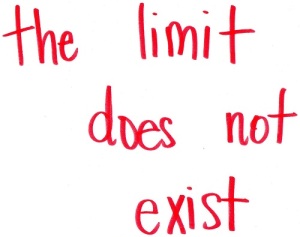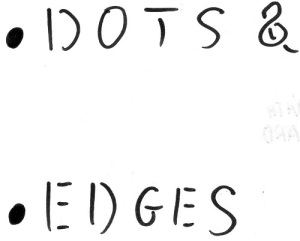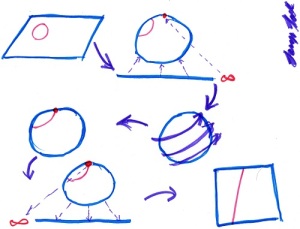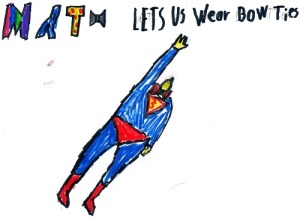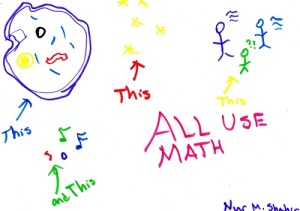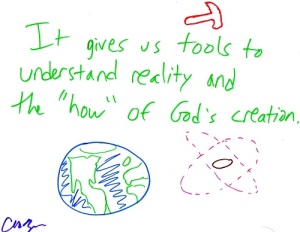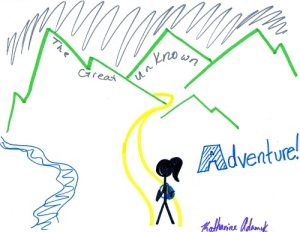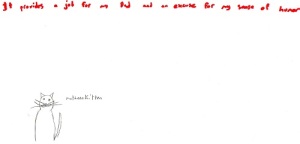Last week, 6,000 mathematicians met in Baltimore. They crowded in conference rooms, swapped gossip over beers, and wherever free food appeared, they lined up like ants.
On a table in the hallway of the convention center, I stationed paper, markers, and the following invitation:
I got 39 replies, 39 tributes to math’s power—in short, 39 ways to love mathematics. In no particular order:
1. Love patterns. Love the hunt. Love that our thirst for patterns is so deep and instinctual that you might call it canine.
2. Love the underground tunnels connecting mathematics. Love that each topic in math is a subterranean river of insight, nourishing lands it scarcely seems to touch.
3. Love the explosion of brain.
4. Love the way math brings out the inner teenager in a professor.
5. Love the way math brings out the inner professor in a teenager.
Here, three high-school students used two sheets to explain their research from last summer. Fifteen years old, they’re already minting new coins for the great bank of human knowledge.
6. Love in-jokes. Love the fact that when you say “I’m a math major,” your classmates might scream, unprompted, “THE LIMIT DOES NOT EXIST!”
7-8. Love families. Love categories of diverse objects, all sharing the same property. Love graph theory.
9. Love physics. Love that math helps us grasp the world, not just with our fingers, but with our thoughts.
10. Love math’s bigness. Love that there’s always more math out there.
11. Love that math can happen anytime, anywhere. Love that it’s an art project of the mind, and your easel is always handy.
12. Love clarity. Love precision. Love the total absence of BS.
13-15. Love visualization. Love the proofs without the words.
16. Love silliness.
17. Love the journey. Love the dead ends, obstacles, and wrong turns—and love reaching the destination, finally.
18. Love biology, astronomy, language, music—and love that math that underlies them all.
19. Love symbols. Love the mystic poetry of numbers, letters and those other, funnier markings interspersed among them.
20-21. Love playing. Love that math gives us an excuse to play.
22. Love the ineffable.
23. Love insight. Love how the world changes, comes awake, comes alive, when you use math to understand it.
24. Love camaraderie. Love meetings of the minds.
25. Love the divine. Love the long tradition of seeing the patterns of mathematics as the fingerprints of something greater than us.
26. Love beauty. Love that math is a uniquely human pursuit.
27. Love the challenge. Love the way it pushes your mind.
28. Love simplicity. Love the clean divide between true and false.
29. Love adventure. Love the great unknown.
30. Love your thesis. Love things you discovered. Love rectangular tilings yielding planar binary trees.
31. Love squares being circles (under the right metric, of course). Love math turning your intuition inside out.
32. Love Fibonacci. Love music. Love quarter-notes separated by Fibonacci rests.
33. Love that it keeps your dad employed, and gives you an excuse to draw a “mathemakitten.”
34-35. Love a chance to use the Greek alphabet, without joining a frat.
36. Love that math creates reality, in more ways that one.
37-39. Love that math means 6,000 different things to 6,000 different people.
Here’s a thought that lingers with me. There’s a thin fault-line running through all our conversations about math. Is mathematics a means, or is it an ends?
On the one hand, math is a warehouse of applications, the world’s favorite toolkit. It enables the technologies and discoveries that have carried our species from caves to houses to rocket ships. In that sense, math is a means.
Math is also a self-contained realm of pure ideas. This doesn’t mean math is insulated from human activity; it means that math is a quintessentially human activity. Math is the pursuit of patterns, not necessarily for the sake of faster computers, but for the sake of the patterns themselves, for the sake of their elegance and beauty. In that sense, math is an ends unto itself.
The two camps sound irreconcilable. But really, these are just the happy and inherent contradictions of a pursuit that transcends even our most focused efforts to describe it.
Math is a means and an ends. It’s a world-changing toolkit and a beautiful world in its own right. Math belongs not just to mathematicians, but to scientists, engineers, financiers, actuaries, artists, even television writers. It belongs to teachers and students and infants learning to count. It belongs to the 6,000 humans who gathered in Baltimore, and to the 7 billion who didn’t.
Thanks to everybody who participated (or who resisted the urge to steal a lollipop as you walked by). Let me know if you’d like to receive credit here for your picture!







